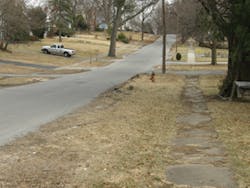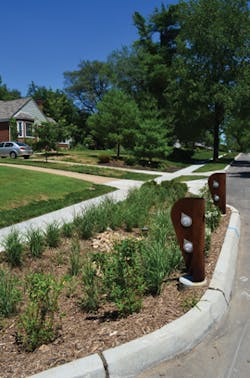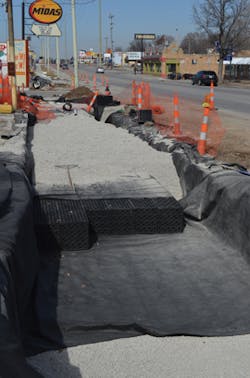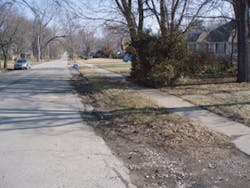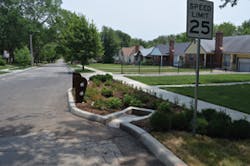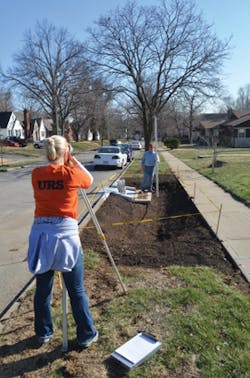Kansas City’s Green Solutions Pilot Project Brings Success to the Surface for Combined Sewer Overflows
The Kansas City, MO, Water Services Department (KCWSD) has embarked on an environmentally progressive project that demonstrates how stormwater improvements can help improve neighborhoods and create community amenities instead of simply being buried underground. In short, it brings success to the surface in multiple, meaningful ways. The project, called the Middle Blue River Basin Green Solutions Pilot Project, commits millions of dollars to a large-scale pilot test of green infrastructure solutions to reduce sewer overflows and improve water quality. The pilot is the first significant green infrastructure component of the city’s Overflow Control Program (OCP) approved by the USEPA. Cities across the country (especially those working with EPA on sewer overflow control plans) are paying close attention as Kansas City conducts what is currently the largest green combined sewer overflow (CSO) control study in the nation.
The city’s OCP goes far beyond regulatory compliance. It represents the largest public infrastructure investment in Kansas City’s history, estimated at $2.4 billion over 25 years. As such, it will do more than just address CSO issues. It will help clean streams and rivers in the area, provide opportunities to create greener neighborhoods, and establish a healthy environment for the future.
Installing porous concrete sidewalk on 75th Terrace
At its core, the goal of the pilot project is to assess the technical and cost effectiveness of using green infrastructure to reduce sewer overflows by keeping stormwater out of the sewers rather than transporting and treating water after it is already in the sewer system. By integrating stormwater controls into landscaping and streetscaping, water can be put to a higher and better use. KCWSD developed a phased approach for the pilot project to evaluate green solutions techniques in a 100-acre drainage area before similar techniques are implemented in the larger 744-acre watershed. Proven and cost-effective techniques from the pilot phase can then be applied across the watershed and city.
When the pilot project concept was developed, KCWSD estimated green infrastructure practices had the
potential to save the city approximately $10 million in capital costs compared to conventional infrastructure techniques. The added benefit of the green infrastructure approach, as opposed to simply putting bigger or separate pipes in the ground, is that green infrastructure actually rebuilds neighborhood streetscapes. For example, rain gardens, stormwater planters, and trees clean the water and air and buffer noise. New sidewalks make walking easier and safer. Curb extensions slow traffic in addition to collecting stormwater. These anticipated benefits, in addition to the potential cost savings, prompted KCWSD to launch the pilot project.
The pilot project tests the technical effectiveness of a wide range of stormwater best management practices (BMPs) along with multiple design variations to determine what is most effective for Kansas City’s landscape, soils, and climate. The project team is also assessing the constructability, cost-effectiveness, maintenance requirements, and community acceptance of the stormwater BMPs.
Kansas City’s Aging Sewer Systems
As is true of many older cities across the country, Kansas City’s sewer systems are aging. Construction of portions of the sewer system began more than 150 years ago, and some are still in use today. Kansas City’s collection system consists of both separate sewer systems and combined sewer systems. In separate sewer systems, sanitary wastewater and stormwater are conveyed in separate pipes. In combined systems, both wastewater and stormwater are carried in a single, common sewer line.
Kansas City has 58 square miles of combined sewer. These locations are largely in the older portions of
town, and the sewers are not able to carry the amounts of stormwater that run off the urban landscape during moderate to large rain storms. When the sewer systems exceed capacity, they overflow and discharge untreated sewage and stormwater to nearby streams and rivers. Each year, CSOs discharge 6.5 billion gallons of untreated sewage. These discharges contribute to high bacteria levels that affect the quality of surrounding water.
With these environmental challenges as the backdrop, Kansas City began developing a citywide OCP in 2003. City officials organized a Wet Weather Community Panel to provide input into the city’s efforts. Incorporated into the OCP planning process were specific goals of the community panel:
- Minimize loss of life and injury, and reduce property damage due to flooding
- Improve water quality
- Maximize economic, social, and environmental benefits
In 2010, as part of a Clean Water Act settlement, Kansas City entered into a consent decree with EPA to reduce the quantity of discharges from CSOs by 5.4 billion gallons a year by 2035. The consent decree also requires Kansas City to use green infrastructure in addition to structural controls to accomplish overflow control.
The Pilot Project
The 100-acre Middle Blue River Basin Green Solutions Pilot Project is located in the older, mixed-use residential and commercial Marlborough neighborhood where stormwater and wastewater flow in combined sewers. Less than 1 inch of rain can cause overflow events in this area. Consequently, green infrastructure has great potential to reduce the number and volume of overflows by reducing stormwater flow rates and volumes reaching the combined sewer system.
Previous projects in other parts of the Midwest, such as the Burnsville, MN, Raingarden Retrofit Study,
demonstrated the ability of stormwater BMPs to reduce flows to storm sewers. The goal of the Kansas City project was to apply similar approaches on a larger scale, and in a more urban area with combined sewers, while also recognizing that Kansas City generally has more severe storm events and is dominated by clay soils.
Along with providing valuable data regarding the ability of green infrastructure to reduce combined sewer overflows and stormwater runoff, the pilot project is also assessing construction and maintenance techniques and costs, helping advance green design standards for Kansas City, evaluating public involvement approaches, and gauging public acceptance of green infrastructure. Construction of the green infrastructure began in spring 2011 and was substantially completed in July 2012. Approximately 150 BMPs, providing 370,000 gallons of storage volume, are now complete. These include:
- 91 rain gardens, bioretention gardens, and bioretention gardens with below-grade storage systems
- 36 curb extension planters to collect stormwater and slow traffic
- Almost 400 feet of bioswale
- Two cascading bioretention gardens on steep streets
- More than 5,200 feet of porous concrete sidewalk
- Over 1,000 feet of permeable paver sidewalk combined with below-grade storage systems
Along with the varied BMPs, the project team designed multiple variations of BMP elements, such as inlets, underdrain systems, risers, trash screens, permeable pavement systems, and below-grade storage systems, as well as plant selections, to test new design details for the local climate and landscape.
A “Before: photo on 76th Street, a residential street
The major challenge of this project was narrow spaces; all BMPs had to be located within street rights of way. Surface features are largely located between street curbs and sidewalks, while below-grade storage systems are located beneath sidewalks and roads. Because the overarching goal of the project was to reduce stormwater flow rates in combined sewers—and space for infiltration BMPs was limited—many of the BMPs collect and detain runoff in below-grade storage. Runoff is then released to the sewer system over a 24-hour period via controlled-release orifices in outlet devices. Approximately 75% of the BMP storage volume is contained in below-grade storage systems; the remainder is provided in the surficial rain garden and bioretention garden beds. Since the performance of the project did not count on infiltration, the project team anticipates that performance will continue to improve over time as garden plants mature and increase infiltration rates.
The project was designed to control runoff from a 1.4-inch rainstorm, which is the 90th percentile storm in Kansas City. Hydraulic modeling conducted for the project indicates the system of BMPs constructed for this project area will reduce the peak runoff flow rate for a 1.4-inch storm event by approximately 80%.
Francis Reddy, P.E., senior registered engineer of the KCWSD, managed the project from design development through construction. Under his leadership, the project team integrated more than 2.5 miles of sewer line rehabilitation and approximately 2 miles of new curb and sidewalk with over 150 stormwater BMPs. The integrated design approach is the specialty of the Green Solutions Team of URS Corporation in Overland Park, KS, the city’s design partner in the project.
To assess the long-term effectiveness of the green solutions, Kansas City is partnering with EPA’s Office of Research and Development Advanced Drainage Concepts Team (EPA ORD, EPA Region 7, University of Missouri-Kansas City, Mid-American Regional Council, University of Alabama-Tuscaloosa, Tetra Tech, and Michael Ports) to conduct a multiyear monitoring program. This EPA-funded and -led project will assess the flow reductions and water-quality benefits of the project and will help quantify the economic benefits of the green infrastructure.
Public Outreach and Input
From the start, public input was treated as an integral part of the design process by both URS and KCWSD. Technical design tasks were combined with extensive community involvement to gain support from neighboring residents and businesses and to measure how well the public involvement approaches were working in rallying support for the project. Outreach activities included offsite community meetings, front yard street meetings with residents, recruitment of block captains, engagement with neighborhood associations, door-to-door meetings with business owners, and distribution of information materials through numerous media including online, mailings, and door hangers.
Below-grade storage pipe installed beneath a number of curb extensions and bioretention gardens
While the pilot project was developed to address sewer overflows, residents expressed concerns over day-to-day neighborhood issues such as damaged sidewalks, street repairs, and cars speeding through the community. KCWSD and URS opted to address these concerns with additional sustainable solutions to integrate streetscape improvements into the design. These improvements, which included new sidewalks, porous sidewalks to collect stormwater, street repairs, curb extensions with stormwater BMPs to slow traffic while collecting runoff, and rain gardens integrated into the landscaping, further demonstrate that stormwater improvements can benefit communities beyond just improving water flows. KCWSD’s public involvement team also partnered with EPA to encourage residential downspout disconnections and the installation of residential rain barrels and rain gardens.
Beyond the Pilot Project
This pilot project is simply the beginning of a large effort to address the CSO and sanitary sewer overflows (SSOs) in the city. Kansas City is proceeding with its long-range effort to implement overflow measures intended to eliminate a substantial percentage of CSOs and SSOs by the end of 2035. The CSO program, combined with existing controls, will eliminate or capture for treatment approximately 88% of the typical wet-weather flows in the city’s combined sewer system. The OCP includes specific requirements for:
- Sewer separation and repair projects,
- Construction or expansion of treatment facilities,
- Development of diversion structures to reroute wet-weather flows,
- Construction of tunnels and storage tanks to provide additional capacity for wet-weather flows,
- Improvements to control systems, and
- Sewer rehabilitation projects.
Checking grades in rain gardens
These conventional infrastructure improvements will proceed as planned. However, with lessons learned from the Middle Blue River Basin Green Solutions Pilot Project, Kansas City will continue to integrate green solutions throughout the city and apply the most effective, financially responsible and aesthetic approaches to begin reducing flows to the collection system while also revitalizing neighborhoods throughout the region.
The Project Team
Leading the project for Kansas City’s Water Services Department are Terry Leeds, P.E., director, and Reddy, project manager. The design team on the project was led by URS Corporation of Overland Park, with support from DRG Engineers, Taliaferro & Browne, and Vireo Consultants of Kansas City, plus Barr Engineering from Minneapolis, MN. The public involvement team included Shockey Consulting Services, Parson & Associates, and Libretto Communications.
Acknowledgement
URS thanks the designers of the Burnsville study, Kurt Leuthold and Fred Rozumalski of Barr Engineering, who generously shared their experience and lessons learned during the design phase of the Kansas City project.
